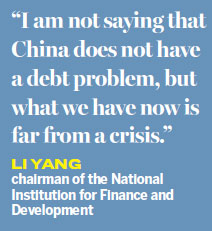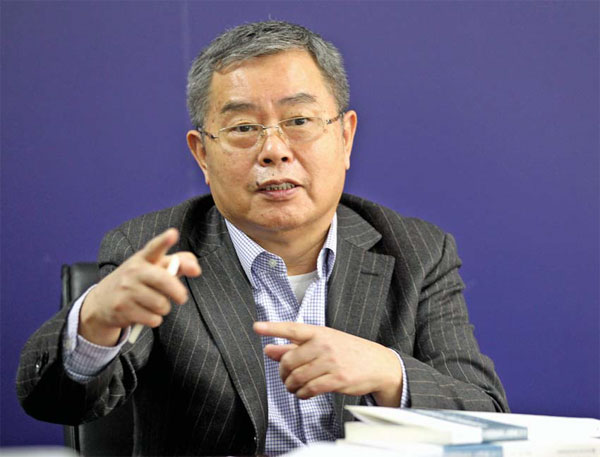Economist: China has debt problem, but no crisis
|
Li Yang, chairman of the National Institution for Finance and Development, insists there has been no equivalent example in China to the US bailing out Fannie Mae and Freddie Mac, the entities at the heart of its mortgage crisis. Zhang Wei / China Daily |
Many analysts focus on country's ratio of debt to GDP, but reality is more nuanced, says Li Yang
Li Yang, the influential Chinese economist, insists the world's second-largest economy is not facing a debt crisis.
The 65-year-old chairman of the National Institution for Finance and Development, a leading think tank, says commentators always underestimate the country's huge asset base.
"I am not saying that China does not have a debt problem, but what we have now is far from a crisis," he says.
Li, former vice-president of the Chinese Academy of Social Sciences and five-time winner of the Sun Yefang Economics Prize, China's highest award in the field, was speaking in his offices in the Jingguang Center in the Hujialou area of Beijing.
Many analysts get their assessments wrong, he says, because the government's debt problem can't be understood by simply looking at the debt-to-GDP ratio.
By that measure China's debt is at a historical high - 249 percent at the end of last year, according to the NIFD.
"The problem with this analysis is that debt is a stock and GDP is essentially a flow. If we use this measure, it is not in any way a scientific explanation of the real situation," he says. "We either need to measure debt as a stock to stock or a flow to flow."
The work of Li's think tank, one of 25 with national level status approved by the central government in 2015, has been to analyze the Chinese economy's assets. It has published its research in two volumes, The National Balance Sheet of China, in both 2013 and 2015.
With a team of seven full-time researchers, it conducted what is believed to be the most comprehensive research into this area ever undertaken.
"We have so far collected more than 10 years of data to look at the real composition of China's assets," he says. "Starting next year we will be producing our research annually, with an updated volume every year."
By the end of 2015, according to the institution's latest data, China had some 229.4 trillion yuan ($33.3 trillion; 31.3 trillion euros; 26.9 trillion) of assets and 126.2 trillion yuan of debt, resulting it net assets of 103.2 trillion yuan.
Of these net assets, 16.6 trillion yuan was owned by the central government and 69.1 trillion yuan by local governments.
According to the same calculation, some 20.7 trillion yuan were held in highly-liquid assets, including precious metals such as gold and silver, and in investments in foreign companies listed on overseas exchanges.
"This high degree of liquidity puts China in a strong position to deal with any crisis," Li says.

One of the aspects that differentiates China's debt from that of many Western countries is that it is invested in things that are tangible and that produce an income such as infrastructure, rather than funding pensions and other ongoing expenses - which he says is particularly the case in the United States and most developed economies.
"With economic growth slowing and investment return declining, the government's revenue is shrinking but we have this huge amount of accumulated wealth - net assets to cover the shrinking revenue stream," he says, adding that investment in infrastructure, although not always income generating in itself, can trigger other revenues:
"If you take the case of Shanghai, if a tunnel is built under the Huangpu River, it may not generate revenue directly for the municipality but it makes businesses more efficient and people's lives more convenient. And the value of the land at both ends might rocket, bringing in revenue for local government."
Li says there are increasing opportunities for local governments to create income from infrastructure through public private partnerships.
"Through such partnerships, private companies can help generate revenues for local governments," he says.
Li, whose education was interrupted by the 'cultural revolution' (1966-76), eventually graduated in economics from Anhui University in his native province in 1981.
He went on to earn his master's degree at Fudan University in Shanghai before completing a doctorate at Renmin University of China in Beijing.
He then spent a year as a visiting economist at Columbia University in New York in the late 1990s before returning to China to work at the influential social sciences academy, where he rose to vice-president. The National Institution for Finance and Development is also part of CASS.
Over a long career he has written more than 400 theses and working papers and participated in 50 state-level research projects.
He believes the view that many of the problems now facing the Chinese economy - boiling down to the government's 4 trillion yuan stimulus package implemented after the global financial crisis in 2009 - does not reflect the true condition of the country.
"There was probably only 1.1 trillion yuan ever actually spent, and much of that was already in the plan so it was not additional expenditure," he says.
He disputes the view of Tsinghua University professor of finance Zhu Ning expressed in his new book, China's Guaranteed Bubble, that there is little concept of debt risk in China because there is an implicit guarantee the central government will always come to the rescue.
He insists there has been no equivalent example in China to the US bailing out Fannie Mae and Freddie Mac, the entities at the heart of its mortgage crisis.
"The US government bought their assets when they were in a quagmire, and that is why the debt problem in the US shifted from private enterprises to the government."
Li, however, fully acknowledges that China is not immune from a debt crisis and, in fact, experienced one after the Asian financial crisis when GDP growth suddenly slumped to 4 percent.
"At the time, the Western media said that we were heading for bankruptcy and Chinese institutions were going broke. We spent around 5 trillion yuan of our stock in assets, however, to absorb almost all the non-performs' debt."
Li says he believes that, unlike the economies directly affected by the Asian financial crisis, such as South Korea and Thailand, China's debt is owed internally within its own financial system rather than externally to foreign countries, giving it extra insurance against any crisis.
"If you look at Japan now, it has a huge debt-to-GDP ratio, but it doesn't have a debt crisis because much of its debt is owed internally. Many European countries have a lower level of debt, but they have no assets and have to borrow money from other countries. They are in a far worse position."
Li acknowledges that China needs to reduce its current debt level, and that this is one of the factors that characterize the era of the "new normal" of lower growth.
"Writing off debt, however, is just one of the reasons, alongside unbalanced development and overcapacity, for slower growth," Li says. "I don't believe we are going to see some sudden collapse in growth. I expect it to move to around 5.5 or 5 percent by 2030."
Contact the writer at andrewmoody@chinadaily.com.cn

















